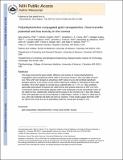| dc.contributor.author | Sharma, Ajay | |
| dc.contributor.author | Tandon, Ashish | |
| dc.contributor.author | Tovey, Jonathan C.K. | |
| dc.contributor.author | Gupta, Rangan | |
| dc.contributor.author | Robertson, J. David | |
| dc.contributor.author | Fortune, Jennifer A. | |
| dc.contributor.author | Klibanov, Alexander M. | |
| dc.contributor.author | Cowden, John W. | |
| dc.contributor.author | Rieger, Frank G. | |
| dc.contributor.author | Mohan, Rajiv R. | |
| dc.date.accessioned | 2013-11-15T16:55:01Z | |
| dc.date.available | 2013-11-15T16:55:01Z | |
| dc.date.issued | 2011-08 | |
| dc.date.submitted | 2010-10 | |
| dc.identifier.issn | 15499634 | |
| dc.identifier.uri | http://hdl.handle.net/1721.1/82126 | |
| dc.description.abstract | This study examined the gene transfer efficiency and toxicity of 2-kDa polyethylenimine conjugated to gold nanoparticles (PEI2-GNPs) in the human cornea in vitro and rabbit cornea in vivo. PEI2-GNPs with nitrogen-to-phosphorus ratios of up to 180 exhibited significant transgene delivery in the human cornea without altering the viability or phenotype of these cells. Similarly, PEI2-GNPs applied to corneal tissues collected after 12 hours, 72 hours, or 7 days exhibited appreciable gold uptake throughout the rabbit stroma with gradual clearance of GNPs over time. Transmission electron microscopy detected GNPs in the keratocytes and the extracellular matrix of the rabbit corneas. Additionally, slit-lamp biomicroscopy in live animals even 7 days after topical PEI2-GNP application to the cornea detected no inflammation, redness, or edema in rabbit eyes in vivo, with only moderate cell death and immune reactions. These results suggest that PEI2-GNPs are safe for the cornea and can potentially be useful for corneal gene therapy in vivo. | en_US |
| dc.description.sponsorship | National Institutes of Health (U.S.) (RO1EB000244) | en_US |
| dc.description.sponsorship | Research to Prevent Blindness, Inc. (United States) | en_US |
| dc.language.iso | en_US | |
| dc.publisher | Elsevier | en_US |
| dc.relation.isversionof | http://dx.doi.org/10.1016/j.nano.2011.01.006 | en_US |
| dc.rights | Creative Commons Attribution-Noncommercial-Share Alike 3.0 | en_US |
| dc.rights.uri | http://creativecommons.org/licenses/by-nc-sa/3.0/ | en_US |
| dc.source | PMC | en_US |
| dc.title | Polyethylenimine-conjugated gold nanoparticles: Gene transfer potential and low toxicity in the cornea | en_US |
| dc.type | Article | en_US |
| dc.identifier.citation | Sharma, Ajay, Ashish Tandon, Jonathan C.K. Tovey, Rangan Gupta, J. David Robertson, Jennifer A. Fortune, Alexander M. Klibanov, John W. Cowden, Frank G. Rieger, and Rajiv R. Mohan. “Polyethylenimine-conjugated gold nanoparticles: Gene transfer potential and low toxicity in the cornea.” Nanomedicine: Nanotechnology, Biology and Medicine 7, no. 4 (August 2011): 505-513. | en_US |
| dc.contributor.department | Massachusetts Institute of Technology. Department of Biological Engineering | en_US |
| dc.contributor.department | Massachusetts Institute of Technology. Department of Chemistry | en_US |
| dc.contributor.mitauthor | Klibanov, Alexander M. | en_US |
| dc.contributor.mitauthor | Fortune, Jennifer A. | en_US |
| dc.relation.journal | Nanomedicine: Nanotechnology, Biology and Medicine | en_US |
| dc.eprint.version | Author's final manuscript | en_US |
| dc.type.uri | http://purl.org/eprint/type/JournalArticle | en_US |
| eprint.status | http://purl.org/eprint/status/PeerReviewed | en_US |
| dspace.orderedauthors | Sharma, Ajay; Tandon, Ashish; Tovey, Jonathan C.K.; Gupta, Rangan; Robertson, J. David; Fortune, Jennifer A.; Klibanov, Alexander M.; Cowden, John W.; Rieger, Frank G.; Mohan, Rajiv R. | en_US |
| dc.identifier.orcid | https://orcid.org/0000-0003-3830-714X | |
| mit.license | OPEN_ACCESS_POLICY | en_US |
| mit.metadata.status | Complete | |
